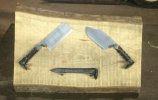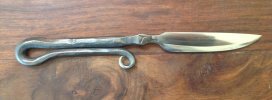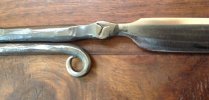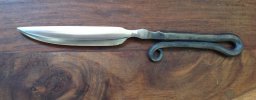Forge welding in a knife steel 'bit' is the easy way. You could also carburize the blade, but this would be a lot of work for what is mostly an "I told you so." Making a spike yourself from a high quality steel is possible, but it would be more work than welding in a bit. As stacy said, take your 5/8 sq bar and upset one end. If you care to, forge the bar down to 9/16 through the length. Taper the end of that bar to a blunt point with maybe 3" of taper. Let it cool, it will do double duty as a drift.
Drill a 9/16" or smaller hole in a piece of 1/2" plate and drift it square over your hardy hole. If you have a sufficiently sized hardy hole, weld on an appropriate sized square tube to the underside of the newly drifted hole. Use a file to relieve a slot on one side of the header, also 9/16" in width, and 3/4' in length. Make it approximately 1/2" in depth at the hole. Orient the slot toward your body when the header is in the hardy hole. place the bar into the hardy hole and using angled blows, pull the material toward yourself (and the slot) prior to further upsetting the material into the shape of a spike head and down into the slot. dome the material and you are done. One truly high carbon spike.
Now, is it worth it? Based on the above process, once you have built your header, I am betting an experienced blacksmith could handforge a spike from parent stock in maybe 3-4 heats (for a simple carbon steel, put some chromium in there and it is gonna take a lot longer). Probably 15 minutes per spike if you really had the process down. That is just a guess. It may take 30. Once you have done that you can forge a knife from it. By contrast, if you have a vertical band saw that can cut steel, you could easily split a spike in maybe a minute. (I am not gonna talk about hot cutting a slot of that length, because it is slower, harder and you will still want to let the spike cool and then grind clean the cut.) Toss the slitted spike into the forge and as it comes to heat, open the slit and flux. Drop in your bar and forge it shut, heat, reflux, bring to welding temp and give it a few whacks. I would grind a V onto the tip of the bbar you will inset to lessen the potential of a void and to present cleaner weld lines. This process will be decidedly faster than forging your own spike, and when etched will look great.
For a cleaner weld line with less wasted material, scarf your spike before splitting by forging bevels into the spike for the length of the inset blade material.






